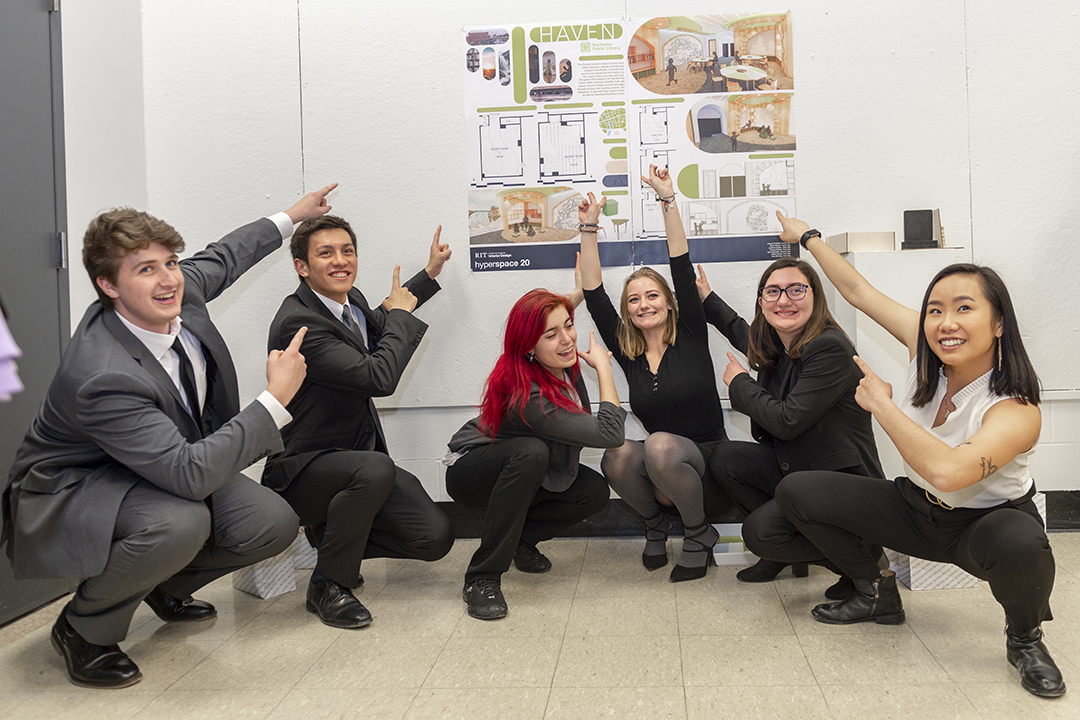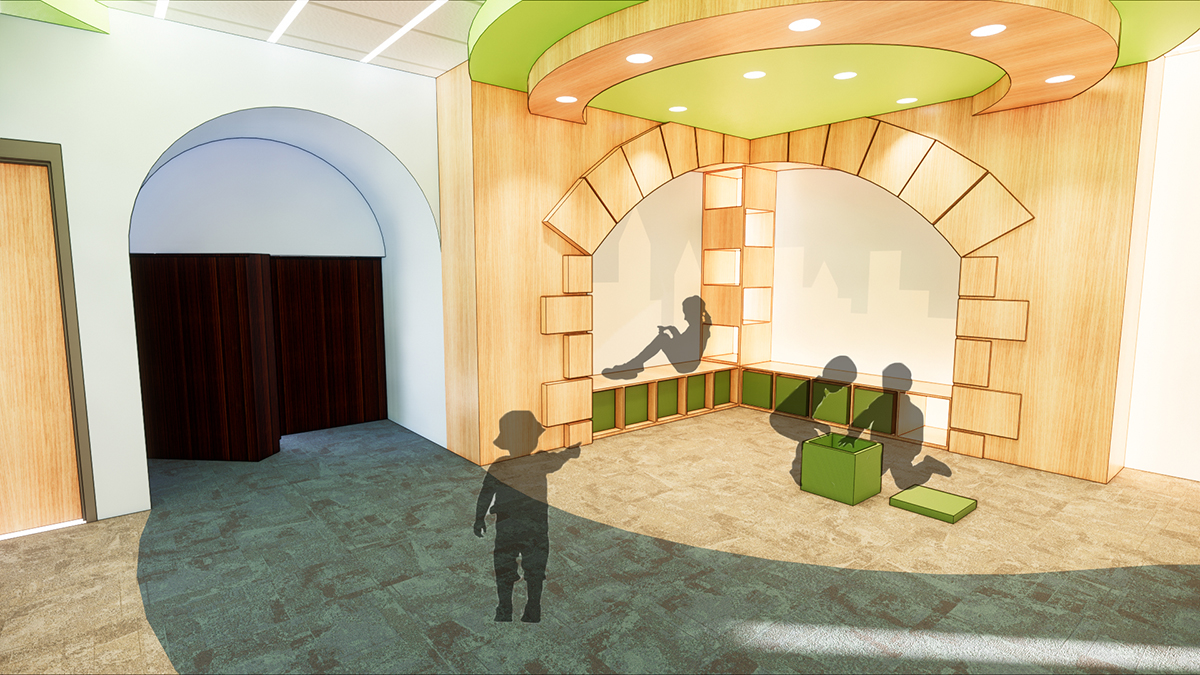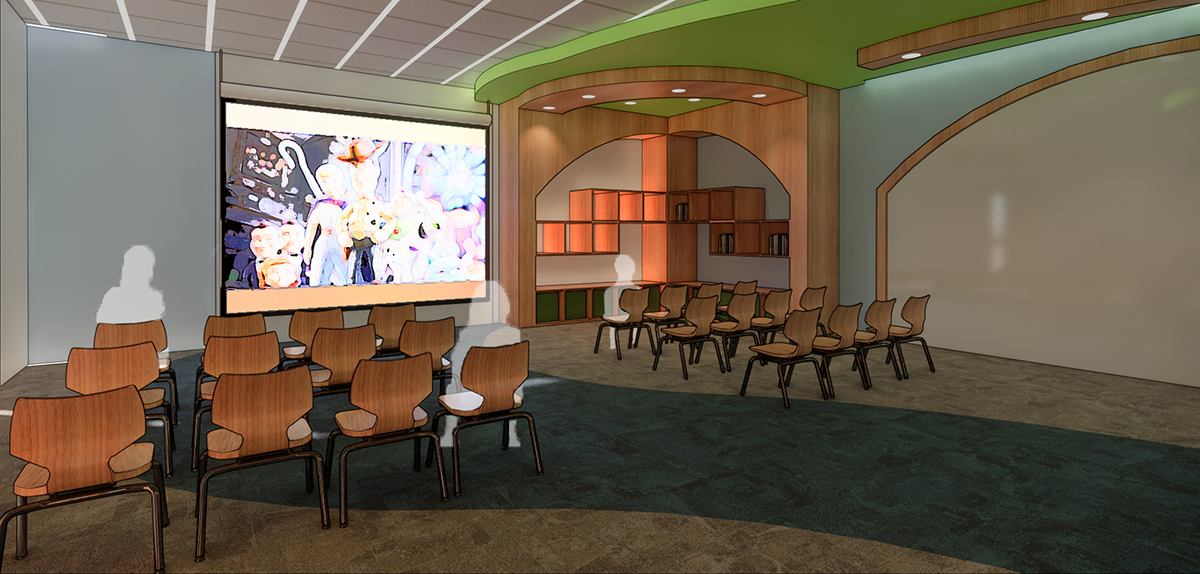Rochester Public Library to use students' design for project build out
Sarah Lenker
The winning team of the Interior Design program's 2020 Hyperspace workshop points to its design that will be used as the basis of the Rochester Public Library's "Secret Room" redesign.
A collaboration between the Rochester Public Library and RIT’s Interior Design program is leading to real-world application of a student project.
In February 2021, the Central Library of Rochester and Monroe County was awarded a Play Everywhere grant from KABOOM! to redesign its historic play and reading room based on a concept developed by Interior Design students.
The design was conceived during the program’s 2020 Hyperspace event, an annual workshop pairing students with a community partner to solve a design problem. Student groups were challenged to redesign the library’s “Secret Room” — a space that’s long hosted programming for children.
The juried workshop’s winning proposal, “Haven,” is a multi-use space that maintains the room’s cultural and historical context to Rochester. Featuring a lively layout referencing area landmarks, with areas for stories, movies, learning and play, it will serve as the inspirational heart of the library’s build out.
“Haven” was designed by Sara Chambers ’22, Gillian Kostek ’23, Amy McFeely ’23, Caroline Pedrotti ’20, Thomas Richter ’21, Jonathan Sutton ’21 and Sarah Vollmer ’20.
"RIT Interior Design was honored at the invitation to support the Rochester Public Library in its effort to revitalize the 'Secret Room' in the Children's Library,” said Assistant Professor Mary Golden, undergraduate program director of Interior Design. “Collaboration with Rochestarians to improve and sustain our local community is at the heart of our annual spring charrette, Hyperspace, and we are delighted to see the KABOOM! Play Everywhere Challenge awarded to the library."
A portion of the "Haven" design.
KABOOM! is a national nonprofit that works with communities to build accessible, inspiring play spaces for kids. In partnership with the Ralph C. Wilson Jr. Foundation, the Play Everywhere Design Challenge awarded $1 million in grants to 19 community-minded projects in Western New York and Southeast Michigan that will incorporate play into everyday moments through creative installations.
Kelly Jahn, Interior Design adjunct faculty, spearheaded the program’s 2020 Hyperspace workshop and relationship with the library. She will remain engaged in the realization of the project by coordinating construction contracts and phasing, obtaining permits and other logistical details.
Jahn worked closely with Brie Harrison, finance director for the Rochester Public Library, to plan the workshop. Harrison said the students’ concepts were used in the library’s grant application and “we believe that the visuals and partnership with RIT helped the library win the KABOOM! award.”
“The RIT Hyperspace challenge was an exciting collaboration for the Rochester Public Library,” Harrison said. “The student-led teams truly engaged deeply with the documents provided as well as listening to staff feedback. At week’s end we were amazed by the level of detail and consideration for the concepts proposed — all teams, not just the winning team, reflected a depth of project knowledge that is typical of a weeks-long project.”
The "Haven" design concept features a theater area.
The project is one of many examples of RIT Interior Design students receiving professional experience through their concepts seeing real-world deployment. It’s also among the opportunities students have had to contribute to the growth and development of downtown Rochester. Other such projects include developing the design and functionality of RIT City Art Space and preparing concepts for the Rochester Music Hall of Fame’s new space.
The redesigned Secret Room will also be a bookend of the Corridor of Play initiative, itself a previously funded Play Everywhere grant project that connects the Strong Museum to the Genesee River.
“It is important for students to work on projects located in the communities they are a part of,” Jahn said. “It helps them develop an understanding of how a building’s interior is an integral part of the urban fabric and plays a critical role in urban redevelopment. The Central Library, including the Rundel and Bausch and Lomb buildings, are in a location that was pivotal to Rochester’s past and currently central to revitalization efforts.”









